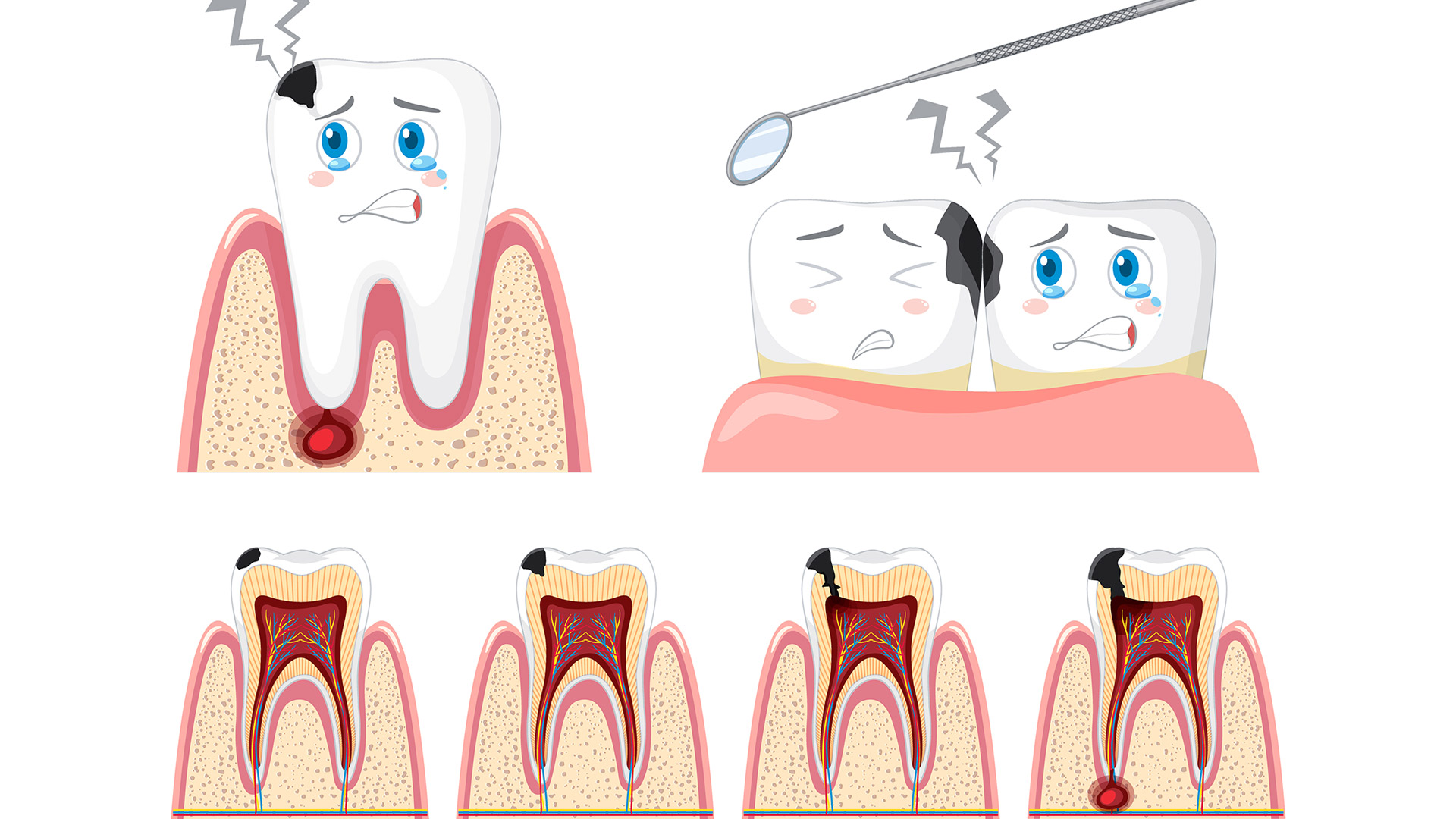Dental caries, also known as tooth decay or cavities, is a common dental problem that affects people of all ages. It can affect your oral health and quality of life. By knowing the types of dental caries, you can prevent and treat them effectively.
What are Dental Caries?
Dental Caries is the breakdown of the hard tissues of the teeth (enamel, dentin, and cementum) by the action of bacteria that produce acids from the sugars in food and drinks. Dental caries can cause pain, infection, tooth loss, and affect the overall health and appearance of the teeth.
There are different types and classifications of dental caries, depending on the location, extent, and progression of the decay. Knowing the types of dental caries can help you prevent and treat them effectively.
Types and Classifications of Dental Caries
According to the location of the decay, dental caries can be classified into four main types:
Pit and fissure caries
These are the most common type of dental caries, affecting the chewing surfaces of the back teeth (molars and premolars). These surfaces have natural grooves and pits that can trap food and bacteria, making them more prone to decay. Pit and fissure caries can be further classified into occlusal (affecting the top surface of the teeth), buccal (affecting the cheek side of the teeth), and lingual (affecting the tongue side of the teeth) caries.
Smooth surface caries
These are the second most common type of dental caries, affecting the smooth surfaces of the teeth that are not in contact with other teeth. These surfaces include the front teeth (incisors and canines) and the sides of the back teeth. Smooth surface caries can be further classified into interproximal (affecting the spaces between the teeth) and cervical (affecting the area near the gum line) caries.
Root caries
These are the type of dental caries that affect the roots of the teeth, which are normally covered by the gums and bone. Root caries can occur when the gums recede due to aging, gum disease, or brushing too hard, exposing the roots to plaque and bacteria. Root caries can cause sensitivity, infection, and tooth loss if left untreated.
Secondary caries
These are the type of dental caries that occur around existing dental restorations, such as fillings, crowns, bridges, or implants. Secondary caries can occur when the restoration is defective, damaged, or poorly fitted, allowing plaque and bacteria to accumulate in the gaps or margins. Secondary caries can compromise the integrity and function of the restoration and the tooth.
The Stages of Dental Caries
According to the extent and progression of the decay, dental caries can be classified into three main stages:
1. Incipient caries:
These are the initial stage of dental caries, where the enamel is demineralized by the acids produced by the bacteria, creating a white spot lesion on the surface of the tooth. Incipient caries can be reversed by remineralization, which is the process of restoring the minerals to the enamel by using fluoride, calcium, and phosphate. Incipient caries can be detected by visual examination, x-rays, or special devices that measure the changes in the enamel.
2. Cavitated caries:
These are the advanced stage of dental caries, where the enamel is destroyed by the acids produced by the bacteria, creating a cavity or hole in the tooth. Cavitated caries cannot be reversed by remineralization, and require dental treatment to remove the decayed tissue and restore the tooth with a filling, crown, or other restoration. Cavitated caries can cause pain, sensitivity, infection, and tooth loss if left untreated.
3. Arrested caries:
These are the inactive stage of dental caries, where the decay has stopped progressing due to changes in the oral environment, such as improved oral hygiene, reduced sugar intake, or increased fluoride exposure. Arrested caries can be recognized by their dark brown or black color, hard texture, and smooth surface. Arrested caries do not require dental treatment, unless they affect the appearance or function of the tooth.
Prevention and Treatment of Dental Caries
The best way to prevent dental caries is to maintain good oral hygiene, which includes brushing your teeth twice a day with fluoride toothpaste, flossing daily, and rinsing with a fluoride mouthwash. You should also limit the consumption of sugary and acidic foods and drinks, and visit your dentist regularly for check-ups and cleanings.
If you have dental caries, you should seek dental treatment as soon as possible to avoid further complications. Depending on the type and stage of the decay, your dentist may recommend one or more of the following treatments:
Fluoride therapy:
This is the treatment for incipient caries, where fluoride is applied to the affected tooth to enhance remineralization and prevent cavitation. Fluoride therapy can be done in the dental office or at home, using fluoride gels, varnishes, rinses, or toothpastes.
Dental filling:
This is the treatment for cavitated caries, where the decayed tissue is removed and the cavity is filled with a material that restores the shape and function of the tooth. Dental fillings can be made of different materials, such as amalgam, composite resin, glass ionomer, or ceramic.
Dental crown:
This is the treatment for cavitated caries that are too large or extensive to be restored with a filling, where the decayed tissue is removed and the tooth is covered with a cap that protects and strengthens the tooth. Dental crowns can be made of different materials, such as metal, porcelain, or zirconia.
Root canal treatment:
This is the treatment for cavitated caries that have reached the pulp or nerve of the tooth, where the infected pulp is removed and the root canal is cleaned, filled, and sealed. Root canal treatment can save the tooth from extraction, but it may require a dental crown to restore the tooth.
Tooth extraction:
This is the last resort treatment for cavitated caries that are too severe or complicated to be treated with other methods, where the tooth is removed from the socket. Tooth extraction can cause problems such as shifting of the adjacent teeth, loss of bone, and difficulty in chewing and speaking. Therefore, it is recommended to replace the missing tooth with a dental implant, bridge, or denture.
Conclusion
If you have any signs or symptoms of dental caries, you should visit your dentist as soon as possible for diagnosis and treatment.
If you are looking for a dental clinic that offers the best dental care and services in Nigeria, you should visit Smile 360 Dental Specialists. We make every visit to our luxurious facility seamless and enjoyable at every level.




